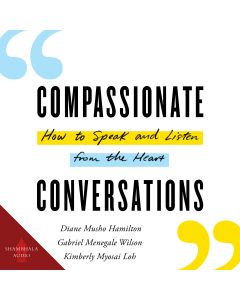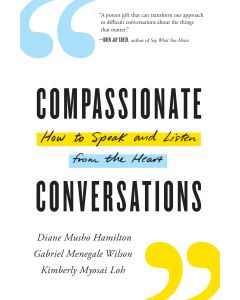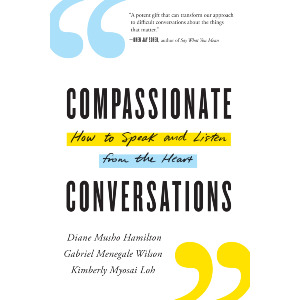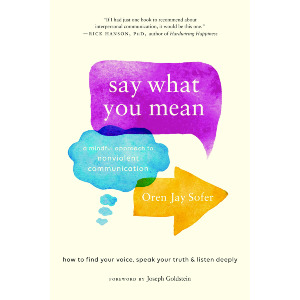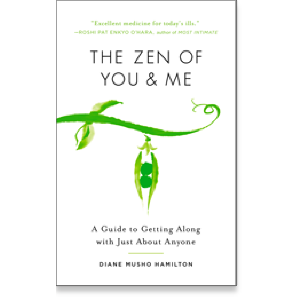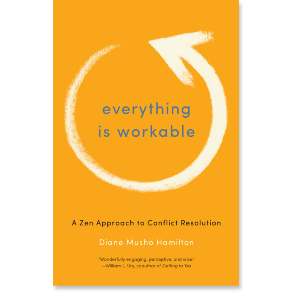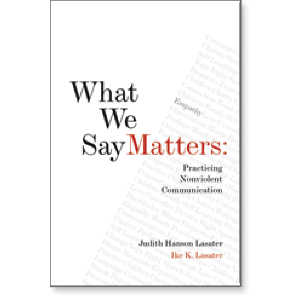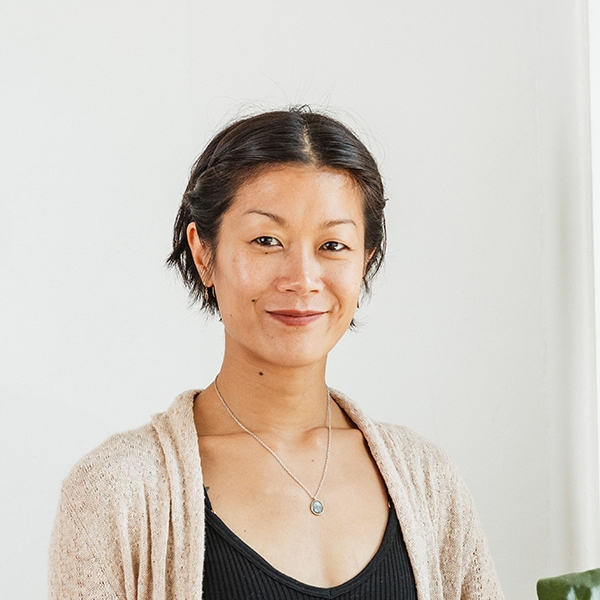

Kimberly Myosai Loh
Kimberly Myosai Loh is a conflict resolution and negotiation specialist, leadership coach and co-author of Compassionate Conversations. She works with conscious leaders and teams to up-level their human relationships and transform conflicts into creative opportunities for growth. Devoted to the values of clarity and compassion, her past work includes peacebuilding and mediation research and advocacy for the United Nations, international NGOs and universities, and international arbitration and litigation work as a lawyer in London and Singapore. Find out more at kimberlyloh.com.
Kimberly Myosai Loh
- per page
GUIDES
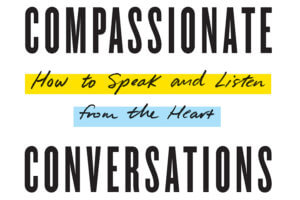
Having a Clear Intention in Conversation
An excerpt from Compassionate Conversations
Intention and Conversation
Having a clear intention will literally help us navigate our conversations when we encounter difficult terrain. To enter a conversation (other than one that is simply social) without an intention is like walking into the wilderness without a compass. And yet we engage in conversations all the time without having one, sometimes without even the vaguest idea of how we would like the conversation to go. Rather than being clear as to what we want, whether it’s to assert our truth, to exchange perspectives, to expand our understanding, to learn about another person’s life, or to practice listening, we go in blind and end up stumbling all over the place. We lose ourselves in dense, hidden motives ranging from wanting to be right and proving others wrong, to flaunting our expertise and establishing dominance. We become entangled in trying to impress others or trying to self-protect. We aren’t prepared for feelings when they crop up, so we ignore or simply cope with them, like wading through unexpected expanses of deserts or boggy swamps. Our important conversations are often rambling, aimless, and in the end, unsatisfying and wearying.
We need a reliable reference point, a North Star if you will, for when the going gets tough.
So in our facilitation work, we insist that our groups always agree on a shared intention for a conversation right up-front. Intentions engage the frontal cortex, that part of the brain involved in thinking, planning, and decision-making. It coordinates our thoughts and actions with internal goals and provides us with a healthy focus. As Robert Sapolsky, a Stanford University professor, neuroendocrinologist, and neurobiologist, points out, “The frontal cortex makes you do the harder thing when it’s the right thing to do.” For example, when anxiety begins to grip the room and we then bring our shared intention to mind, it will often restore relaxation, curiosity, and faith in the process.
Gabriel and Diane organized a workshop that brought together a group of black and white friends to explore and transform their racial dynamics. When putting out the call for the workshop, Gabe explicitly said, “This is a space where everybody, black or white, gay or straight, liberal or conservative, and everyone in-between, must agree to challenge themselves, to grow their heart and communication skills and be accountable to the rest of us. Our intention is to transform our unconscious group dynamics into liberated and mutually affirming relationships.”
Typically, most of us engage in conversations about race, gender, politics, or religion not to grow our heart, but to confirm our own personal beliefs and perceptions, including proving others wrong. Group identity and loyalty to our own tribe has far more influence on what we think, believe, and say than we would like to admit. In this workshop, Gabe deliberately formulated the intention to have conversations that were fresh and revealing, and that gave everyone a chance to grow their skill set. To meet these aims, everyone had to buy into the shared intention. Leaders in human development research assert that individual adults can grow and develop new capacities indefinitely: cognitive, emotional, moral, and even one’s sense of self. And this personal growth can translate to broader cultural change, greater political skillfulness, better leadership, and more effective activism.
Gabe interviewed each person who answered the invitation. He wanted to make sure that their intentions and desires were aligned with those of the workshop. After talking with some potential participants it became clear that the workshop was not appropriate for them. Some were more interested in conversations regarding politics or activism; others wanted to do healing rather than relationship work. Some potential participants felt that the premise that we are all responsible for transforming relationships was faulty since some identity groups have obviously dominated and abused others. But Gabe was clear about the purpose of the conversation he convened. The clarity of his intention helped his friends determine if it was the right conversation for them.
There are all kinds of useful conversations, but they may have very different intentions, and therefore outcomes.
An explicit shared intention serves like a cell membrane for conversation. It includes those who share the intention and excludes those who don’t. This is especially important at a time when in many settings we place a premium on inclusion. We may feel that we need to admit anyone who wants to participate in the conversation, but mixed intentions create mixed results. When people have different purposes and outcomes in mind, conversation can grind to a halt. But with a clear direction, when people have primed their frontal cortex to do the hard thing when it’s the right thing to do, conversations can evolve into creative, energized experiences, where more and more perspectives can come to light.
Resistance, Opposition, and Receptivity
An intention does more than create a positive direction; it also creates resistance and opposition. Have you ever set a New Year’s intention and the first thing you notice is how much you resist it? Have you ever noticed when you commit to a discipline how many of your habits that are precisely the opposite come fully into view? For example, if we intend to listen, we’ll begin to notice all the ways that we simply don’t want to. If we intend to hold multiple points of view, we’ll notice all the times we collapse into one solid, unyielding perspective.
The intention to go up highlights the experience of going down; our desire for this points out how often we do that instead.
But resistance is extremely good news because opposition points to exactly the times, places, and patterns that we need to work with in order to grow our skills. Practice takes time; it requires repetition, and encountering obstacles is intrinsic to our growth and skill-building. Resistance functions like gravity, creating drag on our systems, and overcoming it requires galvanizing strength, ingenuity, and determination. Without resistance, our new habits we’re trying to establish don’t become as strong and durable. So working with intention necessarily includes encountering resistance and dealing with opposition.
Our mistakes and failures are golden opportunities to slow down, examine the moment, and look for alternative responses.
For example, Anthony, an African American participant in the training, shared with the group one of his greatest frustrations about white people: “You all unwittingly promote institutional oppression by enjoying its benefits while being blind to how those very same benefits are not extended equally to people of color. For instance, in my university context, the hiring is often done by committees of people in leadership, all of whom are white. So it’s no surprise that they hire more white people. And then they wonder why we don’t have more diversity in our department.” He went on: “I want a white ally who really gets this!”
His passion and intensity had an enormous impact on the room. After a few moments of letting his message sink in, we asked for a white participant to reflect what he or she had heard Anthony say. Lizzie raised her hand and very deliberately repeated what she had heard: “White people, including myself, enjoy the benefits of our systems and institutions while failing to notice how the benefits exclude people of color.” She mirrored his energy and his frustrations.
She continued: “I’ve done a lot of work on myself, and there is a lot more work I need to do around my blind spots. But here’s what I’ve come to recognize about how I perpetuate white supremacy through the institutions I participate with.” She then briefly shared some poignant examples that showed that she understood first hand his point of view. She also shared the efforts she is undertaking personally to account for the impact of her actions.
“Yeah, yeah, that’s fine, but my colleagues don’t see it, and it drives me crazy!” Anthony protested. Now, it’s important to note that the shared intention of this workshop was to deepen our connection to one another through our differences.
“Hold on” Diane said, jumping into the interaction. “Anthony, you just asked for a white ally who shares your understanding, but I didn’t see you take in what Lizzie just said. How did you hear her? Did her message have any impact on you?”
Anthony seemed startled. He paused, looking back at Lizzie. It was a poignant moment to see him take her in, as if for the first time.
“Yes,” he said, “totally. Thank you for that, Lizzie. Wow. I feel way more relaxed knowing you see this, too.” He reflected further. “It’s crazy that I missed that connection, Lizzie. I think I’m so accustomed to being the only black man on my team, where I’m always the sole person pointing out how institutions perpetuate this. And so I failed to listen to what you were saying because I was just gearing up to make my point again.”
It was a small but intimate moment. Anthony’s role as an advocate, which was brave and difficult, actually took over in his conversation with Lizzie and prevented him from forging a connection with an ally he wanted. His takeaway from the weekend was that while in his activist mode he still needs to maintain an openness to receiving potential allies and connections, who may be closer than he thinks.
An intentional conversation, particularly one focused on the growth of our skills, is geared to disrupt our habitual and reactive patterns so that new perceptions, insights, and skills can come in.
Gabe’s intention was to engage differences and to challenge conditioned patterns and biased views so that everyone in his group could genuinely become one another’s allies. His conversation was meant to free everyone to care more deeply about one another and for their work together.
Mutual intentions create powerful experiences. Gabriel’s workshop participants experienced a way of being with themselves and others that they had been longing for. Inevitably, there came a moment when they realized that the workshop would end, and they would return to the many mixed intentions of everyday life. Gabriel joked with the participants: “Yeah, when you walk into Starbucks they won’t share our intention, and they won’t be using our ground rules. Neither will the other drivers on the freeway. Or the people dealing with your credit card or tech problem. Or the passenger sitting next to you on the airplane. Or perhaps some of your colleagues at the university. But your individual intention will affect and shape the way you show up, and that is the greatest power you have. And the freedom, intimacy, and camaraderie that you thought could never be created or sustained in the real world will simply become who you are. And that change is the best contribution you can make to the world.”
The Practice
- The next time you enter into a casual conversation, take a moment to quietly form an intention.
- At several points during the conversation, revisit that intention and allow it to influence your contribution. Notice whether having a clear intention changed your experience.
Share
Related Books
$16.95 - Paperback
By: Diane Musho Hamilton & Kimberly Myosai Loh & Gabriel Menegale Wilson

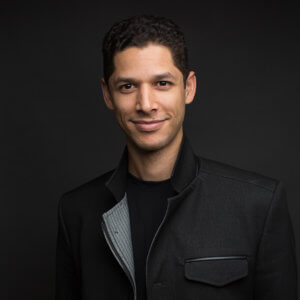


Leading From a Place of Wholeness
by Kimberly Myosai Loh, co-author of Compassionate Conversations
This article is the third in a series of three, sharing perspectives from the book Compassionate Conversation: How to Speak and Listen from the Heart, co-authored by Diane Musho Hamilton, Gabriel Menegale Wilson, and Kimberly Myosai Loh.
Read the first article in the series, “What Makes a Successful Conversation?”
Read the second article in the series, “Conversation Skills to Catalyze Growth”
Across the world, our ways of holding power have evolved enormously in even the last 100 years. Trends in governance demonstrate how we’re moving away from dictatorships and autocracies. The waves of revolutions and social change movements show us that people are no longer submitting to being ruled solely by force and fear. Instead, capturing the hearts of those we may seek to guide and direct is vitally important. This means that people’s core needs, values, and potential must be woven into the shared path forward.
Anytime we are providing direction, advancing the path, or offering our vision in service of a collective group, we are expressing leadership traits. The way we communicate with others involved has everything to do with the success or failure of our proposition.
What Does it Mean to Lead from a Place of Wholeness?
Wholeness is the inclusion of all parts into a cohesive entity. It’s drawing the pieces together to feel their fullness, unified in one place. Both relieving and empowering, it is both a concept and a practice.
Leading a team is complex. When leading, it’s vital to understand the context in which one is navigating: the mapping of connection points and levers, the timeliness of action, and the availability of resources. We must also grasp our internal landscape: the team’s individual and collective strengths, all of the myriad interrelationships, systems of operation, and, importantly, how aligned each person is with the common intention or aspiration. While it’s a lot to take in, we can keep some priorities in mind.
Leaders who lead from a place of wholeness are guided by three important traits:
1. Conscious, clear values
Values in this context are simply what one considers most important. In this article I’m choosing to focus on humility, integrity, and ethical intelligence as examples, but it is for each person to choose for themselves what values they subscribe to and how they will hold themselves accountable. If we accept that power brings with it responsibility, leaders must take on the additional responsibility of ensuring that their decisions are being made in line with chosen value sets, and not consciously or subconsciously corrupted by self-interest.
Humility is the knowledge that each of us is subject to our own limitations. Once we recognize this, we can become curious about opening to others’ perspectives so that we can gain a fuller, more accurate picture of reality. When we can incorporate more points of view, especially from those whose lives will be impacted by those decisions, our strategies and solutions will become more durable and effective.
Integrity guides us to stay true to carefully chosen values and principles that are appropriate for the needs of all relevant stakeholders, even when the circumstances don’t feel convenient. Having a strong sense of integrity is what makes us reliable. In times of increased fear and volatility, being able to trust in our leaders to keep what’s most important squarely at the fore is absolutely invaluable.
Ethical intelligence refers to the soundness of the process we go through in discerning what our chosen values and principles are. For some, this uncovering process is a foundational commitment throughout our life’s work. We can hone our moral compasses by ensuring we take the time to question for ourselves what we believe to be right and why, rather than relying on common opinion.
2. Mature communication skills
In Compassionate Conversations, we discuss basic communication skills, such as listening, reframing, and working with strong emotions. We also discuss more nuanced skills, such as perspective-taking and working with power. In my previous article I explored and offered reflection questions for practicing the key skills of Listening Well, Talking Straight, and Giving Support and Challenge. Other important domains of practice for leaders include giving and receiving feedback, cultivating emotional maturity, and using language skillfully to engage, guide, and motivate members of the team.
While we all benefit from doing this work, leaders have the potential to amplify those benefits because they are modeling a culture of communication for the entire company or organization. When the person in charge habitually interrupts others and diminishes their opportunities to contribute, they are sending a signal about what kinds of behavior are acceptable, and whose voices are worthy of listening. However, if that person instead makes a habit of actively listening to others and seeking their inputs while staying oriented to the main purpose of the group, they are communicating that they care about others’ insights as they discern how to proceed on that issue.
3. Continual development
Leaders who consciously engage their own process of evolution potentiate their growth and allow them to access new perspectives that can inform how they think and act. Here is a passage from Compassionate Conversations that expresses how adult development expands us to include more.
At one time, human development was thought to be complete with adolescence. But research shows that it continues throughout the entire adult life span. (1) . . . In one model of adult development, identity moves through four basic stages: egocentric, ethnocentric, worldcentric, and Kosmocentric.
Through this simple model our sense of self grows from smaller to larger, encompassing more and more experience. As the sense of self becomes more expansive, it also becomes less fixed and more flexible.
These developmental waves of identity have powerful implications for conversation, and while they cannot capture the totality, uniqueness, or mystery of any particular person, they reveal certain broad patterns that can help us understand why our conversations often take the turns they do. (2)
As we describe, development is strongly linked to our notion of identity: who we believe and say we are, our values, and how much we might cling to that. (3) The counterpoint to this mode of being is flexibility. As we practice our willingness to shift away from ways we’ve habitually performed in the past, we can transform in the direction of becoming the leader who is actually needed in the moment.
The beauty of this is that not only are we more available and responsive to what our environments are calling forward from us, but we actually align with the true nature of reality itself. The world, nature and culture are all evolving, and so are we.
Closing the Loop
As a leader, your approach to relationships and communication is mirrored by others throughout your organization. In the complexity of today’s world, anchoring your values in what you deem to be most important will support the soundness of your decisions and others’ ability to rely on you. Committing to practice communication skills and continually grow will show you results over time. People desire to be led by inspiration and emotional connection. When you come from a place of greater wholeness, then you will be able to engage others more deeply and incorporate differences in an interdependent flow. In so doing, you can reduce unintended consequences or harms, and genuinely create better outcomes for everyone involved.
The Practice
Think of a situation in which you have influence where you feel challenged in taking in other points of view and might be defending what you think is the “right way.” Take the time to journal responses to the following prompts, as applied to your scenario:
1. Consciously choose your values
- What values are you relying on?
- What values are others expressing through their points of view?
- Are these sets of values mutually exclusive? Is it possible to weave these values together into a path forward?
2. Take inventory of your communication skills
- When have you been listening well or poorly?
- When do you talk straight or speak in ambiguities?
- When are you offering support and challenge, and to what degree?
- Have your efforts helped result in the outcome sought? If not, why not?
3. Take initiative in your development
- Note down three occasions when someone in your life has disrupted your way of thinking by presenting you with a different perspective.
- How did that information allow you to perceive things from a wider or broader or deeper point of view?
- What did that new vantage point teach you about wholeness in those situations?
(1) Natalie Morad, Part 1: How to Be an Adult—Kegan’s Theory of Adult Development, Medium, November 19, 2017. https://medium.com/@NataliMorad/how-to-be-an-adult-kegans-theory-of-adult-development-d63f4311b553
(2) Hamilton, Wilson, & Loh, Compassionate Conversations: How to Speak and Listen from the Heart, Shambhala Publications, May 19, 2020, 29.
(3) For a good description of the different stages of consciousness, including corresponding values and self-identity, check out Barrett C. Brown, An Overview of Developmental Stages of Consciousness, Integral Institute April 3, 2006. https://integralwithoutborders.org/sites/default/files/resources/Overview%20of%20Developmental%20Levels.pdf
Share
Related Books
$16.95 - Paperback
By: Diane Musho Hamilton & Kimberly Myosai Loh & Gabriel Menegale Wilson


Conversation Skills to Catalyze Growth
By Kimberly Myosai Loh, co-author of Compassionate Conversations
This article is the second in a series of three, sharing perspectives from the book Compassionate Conversation: How to Speak and Listen from the Heart, co-authored by Diane Musho Hamilton, Gabriel Menegale Wilson, and Kimberly Myosai Loh.
Read the first article in the series, “What Makes a Successful Conversation?”
Read the third article in the series, “Leading From a Place of Wholeness”
At each stage of our development, we are stretched to accommodate ever-deepening levels of complexity—in regard to our experiences and ways of knowing ourselves as well as our relationships with others and the rest of the natural world. Our conversations are being called to evolve in parallel with our development, which is also playing out in the collective field. All of the global challenges we face today require an evolution of our human consciousness and a significant boost in the skills with which we communicate.
The emergence of new and different perspectives is, in itself, a hallmark of our cultural evolution. We want to talk about the objective world but also include our subjective, lived experience, feelings, and emotions. As we better understand our wider social conditions, conversations about social justice, diversity, equity, inclusion, and power relationships become necessary. Cultivating empathy and compassion for others helps us speak more effectively and process it all together. It’s a tall order.
Our conversations naturally evolve in response, calling on us to hone our skills and develop our capacities. Sometimes it’s difficult, sometimes awkward, and sometimes extremely frustrating. Yet, for those of us who care about our connections with those around us, and the future world we seek to co-create together, practicing our communication skills is worth our time and energy. Through practice, we can gain flexibility to entertain more perspectives, listen attentively to one another, and see truth in our different experiences of life.
What exactly are the skills that can support us in this endeavor?
1. Listen Well
If we could make only one suggestion for improving our conversations, it would be to practice reflective listening skills. Reflective listening is simple and involves just two steps. First, the listener opens up to hear and fully receive the speaker’s message. Second, the listener repeats the message back to the speaker to confirm they were understood accurately.
By taking the time to thoroughly receive the messages of one another, we make room for each other’s versions of reality, without invalidating them, shutting them down, or fighting back. It can be helpful to remember that listening doesn’t mean agreement.
When we can learn to soothe our nervous systems, stay present, and reflect back what we heard them say without distortion or judgment, the other can experience the relief of being heard and respected, which is fundamentally what we all want.
Reflection Question:
Think of a conversation you had recently in which you struggled to listen to someone else’s point of view. Notice (a) what was happening in your body, and (b) what thoughts or defenses were racing through your mind. Consider what it was that you were resisting. How would the conversation have changed had you been able to let go of your resistance, listen to their point of view, and reflect back what you heard them say?
2. Talk Straight
Talking straight means speaking our truth simply and straightforwardly. Sounds easy but the pitfalls are equally as easy to come by. Sometimes, anxiety about expressing ourselves leads to a tentative or insecure communication style that has us trying to say just the right thing and avoid making any mistakes. On the other hand, we can also overstate our positions and overdo our demands in a way that kills inspiration and discourages others from engaging further.
In conversations we facilitate, we invite participants to speak primarily from the first person perspective. This means using “I messages,” as in “I think . . .,” “I feel . . .,” “I want . . .,” or “I will . . .” By conveying only what is true for us, we don't imply big empirical truths that need to be verified or that invite rejection from others. Nor are we attempting to speak on behalf of a wider group who may or may not fully agree. We’re simply capturing our own direct experience and personal perceptions, and in doing so, we acknowledge that our truths exist in relation to other relevant truths.
Talking straight develops our bravery; it requires us to be forthcoming with our views and it opens us to to receiving feedback or disagreement. Speaking clearly without traces of aggression or negative judgments takes time and practice to accomplish, but through this we learn to trust ourselves and, in turn, to trust others. Eventually we find out how to hear, respect, and integrate our differences.
Reflection Question:
What patterns do you notice in your way of expressing things that are important to you? Do you tend to downplay their importance or rush over them, or do you make your point repeatedly with greater and greater insistence? Or do you tend to do something else entirely? What would it be like to “own” what is true for you? What is a way of talking to others that would comfortably convey your truth?
3. Give Support and Challenge
Both support and challenge are necessary dimensions for our growth. Safe environments offer the benefits of mutual support, belonging, and rapport between group members. This helps us perform better, take healthy risks, and make mistakes. We create safety in our groups by giving everyone a voice, using listening skills, asking questions, and extending goodwill.
On the other hand, we need challenge in order to grow. Challenges keep groups exciting, dynamic, and creative. When we challenge one another, we expand our perspectives to include new information and learn to tolerate the creative tension of our differences.
Finding just the right combination of these two qualities is key, so as to avoid imbalance. Too much support and safety subdues energy and inhibits creative difference. Too much challenge, however, can quickly lead to power-games, heightened intensity, or even aggression. In these cultures, people often shut down and stay silent for fear of attack or criticism.
When we get the balance just right, our teams evolve through encounters and conversations. People in healthy, dynamic teams have one another’s backs and stand for each other’s well-being, while knowing how to ask each other questions and contrast perspectives with the right level of timing, frequency, and intensity to keep things lively and exciting.
Reflection Question:
Which do you tend to emphasize—support or challenge? How would you invite more of the other quality into your life? What difference would that make to your growth and development?
Going Forward Together
Incorporating the three skills of Listening Well, Talking Straight, and Giving Support and Challenge can give us a firm foundation as we traverse the growing complexity in our world. By practicing these, we serve our relationships by showing up more wholly as ourselves and inviting others to do the same. Together, we can grow through hearing and integrating our differences. No matter how new or experienced we are, and no matter how well or poorly the conversations go, our efforts to learn and try are in themselves worthy. Learning is itself a form of evolution, and although it’s sometimes hard to believe, we have faith that our conversations are changing us for the better.
Share
Related Books
$16.95 - Paperback
By: Diane Musho Hamilton & Kimberly Myosai Loh & Gabriel Menegale Wilson


What Makes a Successful Conversation?
by Kimberly Myosai Loh, co-author of Compassionate Conversations
Photo by eberhard grossgasteiger
This article is the first in a series of three, sharing perspectives from the book Compassionate Conversation: How to Speak and Listen from the Heart, co-authored by Diane Musho Hamilton, Gabriel Menegale Wilson, and Kimberly Myosai Loh.
Read the second article in the series, “Conversation Skills to Catalyze Growth.”
Read the third article in the series, “Leading From a Place of Wholeness”
We take the view that successful conversations do not seek to persuade one another of our positions. They aren’t about reducing or ignoring our conflicts, nor even necessarily about getting on the “same page.”
Successful conversations have an incredible capacity to deepen relationships. They allow us to bring forward and reveal our differences, rather than simply cope with them. When we learn to connect through our differences, our conversations may still traverse challenging, awkward, embarrassing, or tense terrain. Nevertheless, by learning to bring forward our truths with honesty and compassion, we fortify our relationships with one another, helping us become more flexible, forgiving, and inclusive.
What does this mean, exactly?
Here’s a passage from our forthcoming book, Compassionate Conversations, that speaks to this:
We rely on one another’s different perspectives in order to see beyond our limited viewpoints, so that we can act, in any given moment, in a way that honors all of us. But this means we have to practice. We have to rouse our good faith, listen intently to one another, ask real questions, and stay present to new perspectives. We must learn to surrender our fixed viewpoints and allow our egos to quake and shutter when we don’t agree or when our perspective is challenged. Through encountering the discomfort of the unknown, we have learned to expand and change. We have so much in common to work with, but we are so distinct, individually and culturally, that we need to openly acknowledge our respective differences so as not to be imprisoned by them. (1)
Learning to have successful conversations takes practice. This takes place in relationship, through the conversations we have. We cannot do it alone.
From my work with mediators, peacebuilders, and conflict resolution practitioners, it is clear to me that all of us have a tremendous capacity to cultivate skills that support successful conversations. These skills include listening deeply and actively, speaking clearly, and giving support and challenge. I’ll dive deeper into these in the next article in this series.
Going beneath these skills, however, we can seek to inhabit a curious mindset that understands that there is a wider, deeper reality beyond any one of our personal points of view. As Robert Kegan teaches, conflict may be arising because we need to recover our truer complexity; our conflict could be a consequence of one or both people making their partial position more true, distinct, and whole than it really is. When in actuality, if one’s view excludes the other’s, and their own valid needs, desires, and questions, then it is incomplete. (2)
When we understand and embody this with humility and an openness to learn, we can genuinely enter into the domain of successful conversations. These conversations will grow us—through becoming open to changing what we think, how we feel, and how we see the world. In this way, our conflicts can be conceived of as teachers, as invitations for us to deepen into relationship, ultimately including more of ourselves and more of the other, in service of creating a more inclusive whole.
(1) Hamilton, Wilson, & Loh, Compassionate Conversations: How to Speak and Listen from the Heart, (Boulder: Shambhala Publications, 2020), 16.
(2) Robert Kegan, In Over Our Heads: The Mental Demands of Modern Life (Cambridge: Harvard University Press, 1994), 319.
Share
Related Books
$16.95 - Paperback
By: Diane Musho Hamilton & Kimberly Myosai Loh & Gabriel Menegale Wilson


